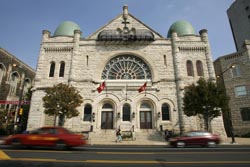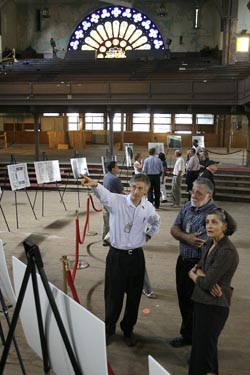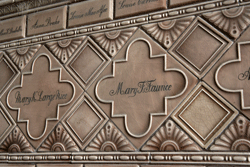Baptist Temple: New life on North Broad
| 215-204-7595 | |
|
When it opened on March 1, 1891, the Baptist Temple was the megachurch of Victorian Philadelphia. With a seating capacity of nearly 4,600, it was the largest Protestant church in the United States. It was built to house the dreams of Russell H. Conwell, a Massachusetts minister who had been called to Philadelphia just nine years earlier. Handsome and possessing a speaking style that made him one of the nation’s most popular orators, Conwell turned “the Temple,” as it was originally known, into a Philadelphia landmark and a community treasure. |
 Photo by Betsy Manning/Temple University Norristown native Thomas P. Lonsdale, whose designs can be found in some of Philadelphia’s trademark structures, was the original architect of the Baptist Temple, which opened in 1891.
|
|
Now, more than 115 years after its doors opened, plans are under way to bring back the Baptist Temple’s grandeur and to re-establish its role as a major North Philadelphia landmark. The more than $29 million renovation is moving forward, the university has hired RMJMHillier to oversee the work and there is a growing excitement about the possibilities. “Temple University and Baptist Temple have a long, shared history,” President Ann Weaver Hart noted. “It is entirely appropriate for us to breathe new life into this vital building and create a monument to the growing vitality of this community.” |
|
 Photo by Ryan S. Brandenberg/Temple University
Staff and faculty tour the historic Baptist Temple during a reception on Sept. 10, where they were among the first to hear about the renovation plans and preview architectural renderings.
|
A parallel history The Temple College was alredy three years old when the Baptist Temple opened its doors. Conwell’s original building was Grace Baptist Church at 12th and Berks streets. In short order, Conwell became a star of the public speaking circuit and his little church became a center of activity in North Philadelphia. Historian and former faculty member Joseph C. Carter, in his three-volume biography of Conwell, noted that the dynamic preacher became a true Philadelphia star. “His fame snowballed partly because of his warmly appealing sermons — so much more practical, colorful, sincere and spiritually uplifting than the stern, gloomy and sleep-inducing theological orations he said he recalled hearing in the plain Methodist church of his boyhood in South Worthington,” Carter said. By the second year of his tenure in Philadelphia, tickets were issued to pew-holders to ensure admission to his services. Hundreds of waiting visitors lined up like star-struck fans seeking last-minute access to the remaining seats. Legend has it that he began teaching young men at night in portions of Grace Baptist Church, including an area known as the “temple” — a precursor to the Temple College and later Temple University. Conwell served as both pastor of the church and president of the college, and he proved to be a master fundraiser for both institutions, as well as the hospital he inspired. By the time the new Baptist Temple opened its doors in 1891, at Broad and Berks streets, the Temple College was already outgrowing the church. |
|
Within 10 years, the college had 4,200 students and needed several local buildings for classes. Both the Temple College and its namesake church flourished as the decades rolled on, and Conwell’s “Acres of Diamonds” lecture was in high demand in the city and around the East Coast. For Conwell, the “Acres of Diamonds” speech wasn’t mere sermonizing — his experience with the church and the college named Temple proved that he would not need to travel far to find those who needed his services, and those who would be willing to support his causes. “So important an enterprise, for the benefit of so large and noble a class of our people, will receive the cheerful gifts of the generous citizens of our city,” he wrote in the Temple College prospectus of 1888. After Conwell’s death in 1925, the Baptist Temple and Temple University moved apart, but maintained a strong link. By mid-century, the Baptist Temple had become a stop for some of the country’s most important intellectual and political figures. Martin Luther King Jr. and President Franklin D. Roosevelt spoke there, as did anthropologist Margaret Mead. Anne Sullivan and her famed pupil, Helen Keller, spoke at the Temple as well as Gen. Dwight Eisenhower when he was president of Columbia University. Alistair Cooke and Edward R. Murrow also delivered Commencement addresses within its walls. Moreover, Temple University events including freshman orientations were held in Baptist Temple’s massive interior, well into the 1960s. By the early 1970s, the Baptist Temple’s congregation was increasingly moving to the suburbs. In 1972, the church’s trustees purchased land in Montgomery County and built a new church. Two years later, Temple University purchased the building. Temple’s plans for the old building have varied in the intervening years, with its destruction or renovation frequently discussed, but never put into motion — until now. Surprises and potential William Bergman has a personal history with the Baptist Temple. While a City of Philadelphia police officer, he was inducted as an honorary member of the Chapel of the Four Chaplains, located in the church’s lower level. The chapel, dedicated by President Harry S. Truman in 1951, honors the heroism of four World War II army chaplains — two Protestant, one Jewish and one Catholic — who gave up their life preservers to save GIs when the USAT Dorchester was sunk by Germans in the North Atlantic. As vice president for facilities at Temple, Bergman has walked through the Baptist Temple on many occasions. Each time, he comes away amazed. “It’s an incredible building,” Bergman said. “We’re still finding surprises in there, things people have not seen in years.” Take the main set of front doors of the building that open out onto Broad Street. When the university purchased the building, a set of storm doors kept the rain and snow out. One day, while repairing damage from a storm, workers discovered a set of “pocket doors” in the church’s walls. The doors, with their stained glass, had been hidden for more than 30 years. “That’s the kind of thing that happens in Baptist Temple,” Bergman said. “This is a very, very exciting project.” Ken Jacobs agrees. An architect with RMJMHillier, he has been impressed by the opportunities the building provides. He also believes the transition from religious to performance space is a natural one for Baptist Temple. “When it was built, it didn't look like a church, it didn't feel like a church — it felt more like a theater,” Jacobs said. Even today, with the seats removed and so many of its original features fading or in disrepair, the majesty and power of its earlier life is evident. “You can only imagine what it was like in its heyday,” he said. At the same time, the huge space presents some challenges as plans move forward to adapt the space as a multipurpose hall that could accommodate concerts, lectures or convocations. A wall will have to be built at the front the church to baffle some of the auto and subway noise from busy North Broad Street, sounds that were not an issue when the church was built in the horse-and-buggy era. While there will need to be substantial changes in the interior, the goal for Temple and RMJMHillier is to respect the building’s history as much as possible. The stained-glass windows will be preserved, and the exterior will remain much as it has been for decades. A bright future When work is finished, the Baptist Temple will serve as the premier gathering place on North Broad Street, hosting lectures, symposia, commencement ceremonies and prominent public speakers, and serving as the new home of the Temple orchestra and choirs, theater performances, operatic productions, jazz concerts and ballet recitals. The renovated facility will include an expanded lobby and reception areas for pre- and post-event gatherings of all kinds. Returning this historic facility to its roots as a venue for entertainment and inspiration will not only serve the evolving needs of Temple’s Main Campus, it will also help to anchor the university as the northernmost point of Philadelphia’s Avenue of the Arts. The university and architect are also committed to honoring the building’s past. Tablets and tiles that commemorate the many donors who helped build and maintain the church have been retained and, where possible, will be used in the renovation. And old features will be given new life. The impressive stained-glass half-rose window at the front of the church is a distinctive element that sends colored light softly into the church. When the building is ready for occupancy, now tentatively scheduled for the end of 2009, it will also shine out on Broad Street, announcing a new era for a Philadelphia landmark. |
|
|
Take part in the Baptist Temple’s rebirth As part of the Together for Temple staff and faculty campaign, the university is extending naming opportunities at all levels of giving in support of the Baptist Temple renovation. Whether you choose to name a seat in the auditorium, sponsor a lecture or event space in the building’s stunning interior, or simply add your name to the Baptist Temple’s honor roll of donors, you can make your mark on Temple history by making a gift today. To find out more, contact the Office of Institutional Advancement at 215-204-1001 or visit www.myowlspace.com. |
 Photo by Betsy Manning/Temple University Russell Conwell was a master fundraiser; tablets and tiles that commemorate the many donors who helped build and maintain the church have been retained and, where possible, will be used in the renovation. |